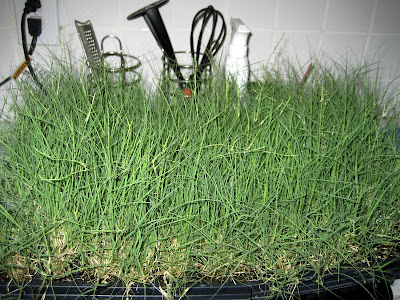The Buffalo Grass Project
If you have been reading my blog you may have read that about a month ago I attempted to plant grass in our front yard and it was a complete failure. Almost serendipitously through my failure I stumbled on to a local nursery's website and learned about Buffalo Grass. Unlike other grass (even Bermuda) Buffalo Grass only requires watering once weekly. The particular variety I was interested in was specifically developed for California by some UC scientist. And best of all according to my calculations it would only cost 42 dollars to cover the front yard. It seemed to be the perfect grass for me and I was very excited about putting it in our yard. So to prepare for planting the grass Ed killed our front lawn. Unfortunately I realized that I miscalculated. I thought my lawn was only 100 square feet and it turns out it is 1100 square feet so I was looking at about 500 dollars to cover the front yard. So those are the events that spurred on the Buffalo Grass Project. You see I thought it would take me forever to save 500 dollars plus come across a weekend where it would be cool enough to want to work outside all day. Plus I'm on a time limit. I need to plant the grass before October. So I decided why not install 100 square feet at a time. This means probably every couple of weeks I could invest 50 bucks and a couple hours of labor into my lawn and come October it would be complete. So today is the first day of the buffalo project. I bought the grass yesterday from Takao Nursey and they have been so helpful during this process. They gave me a little installation booklet and said to call them if I have any problems.
 Ed and I went to the store today and got some Miracle Grow and Weed Control. Next Ed spray painted on the lawn where the plugs would go.
Ed and I went to the store today and got some Miracle Grow and Weed Control. Next Ed spray painted on the lawn where the plugs would go.  Then he drilled holes for the plugs
Then he drilled holes for the plugs  and finally I filled the holes with the plugs.
and finally I filled the holes with the plugs. And here is the finished project. It should take approximately 30 days for the plugs to fill in. Hopefully we will be able to keep them alive and prevent the weeds and other grasses from taking over.
And here is the finished project. It should take approximately 30 days for the plugs to fill in. Hopefully we will be able to keep them alive and prevent the weeds and other grasses from taking over. 

